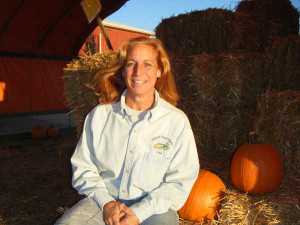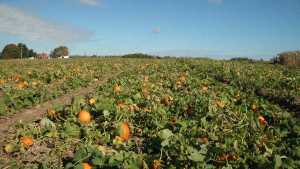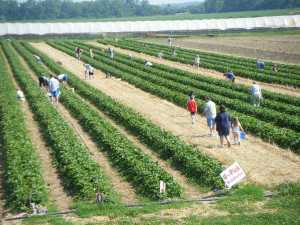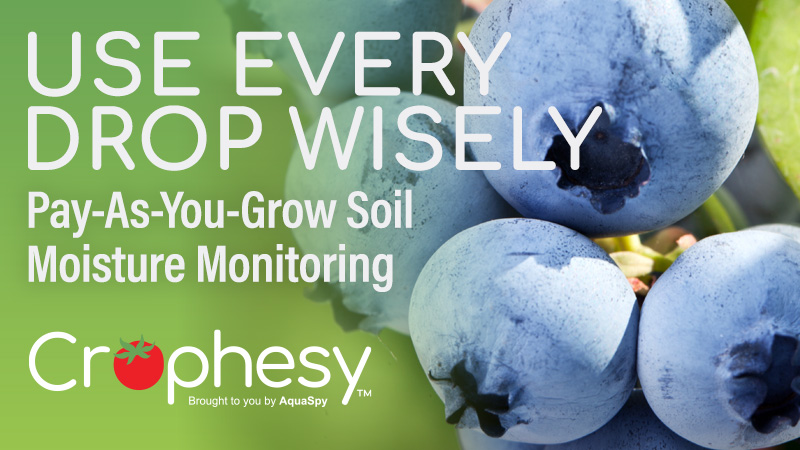How U-Pick Farming Can Be A Sustainable Option For Your Operation
If the idea of letting strangers onto your farm to harvest your crops without any previous experience or training sounds a little strange — or worse yet, dangerous — then perhaps all you need is a little perspective.

Lisa Schacht of Schacht Farm Market in Winchester, OH.
Vegetable growing operations across the country have incorporated U-Pick or “pick your own” (PYO) options into their farms for several reasons — supplemental income being paramount — and are reaping the rewards, whileat the same time promoting agricultural awareness to the public.
One operation in particular, Schacht Farm Market in Winchester, OH, has experienced the benefits of the U-Pick trend over the last couple decades, and is using it as a way to remain sustainable and to offer a valuable experience to community members interested in getting their hands dirty and learning where their food comes from.
The Schacht’s U-Pick offerings include strawberries, peas, green beans, tomatoes, peppers, pumpkins, and fall greens. Of the 130 acres the Schachts have on their central Ohio farm, 5 are dedicated solely to U-Pick vegetables.
When they initially incorporated U-Pick into their farm in the ‘90s, owners Lisa Schacht and her husband David were motivated by a different set of circumstances than you might associate with the trend now. At the time, most of the Schachts’ crops required hand harvesting, and they were having trouble amassing enough labor to get the job done.
They saw the trend cropping up in other area farms and used that as an opportunity to bring people onto the farm, give them direct access to the produce, and get help with some of the hard work.
“Our intent was, if these people are interested in doing this, and we need the work done, why not offer them the opportunity to do it themselves?” she says.
During the ‘80s, as Schacht explains it, a lot of her U-Pick customers would come to the farm to stock up on fresh fruits and vegetables in the fall for the winter. But in the ‘90s the trend evolved to a more “experience-oriented” activity, where people became interested in spending time with their family outdoors in a rural setting.

Of all the crops the Schachts have offered in their U-Pick operation, pumpkins are by far the easiest and safest for the customers to pick.
Choose Crops Carefully
In the beginning, the Schachts offered a limited selection of crops as U-Pick because they realized they were essentially allowing unskilled laborers onto the farm to harvest crops, and they needed to be able to control the situation.
The U-Pick crops had to be easily identifiable at maturity, sturdy, and be able to tolerate a variety of picking styles, so they went with strawberries in the springtime and pumpkins in the fall.
A lot of careful consideration goes into choosing the right U-Pick crops, and Schacht has used both trial and error and common sense to determine what works, and what does not.
Of all the crops she’s offered, she says that pumpkins are by far the easiest and safest for the customers to pick, because at harvest time the plant is already on its decline, and its handles make for easy picking. She also mentions that greens have been a good option for her customers, but require a little more supervision and guidance, which her workers are more than happy to provide.
What Doesn’t Work
Crops that Schacht has had difficulty with and has decided not to offer as U-Pick include tomatoes, asparagus, and sweet corn.
She experimented with tomatoes for a while, and saw that the long season and the intensive care the crop needed was causing more trouble than it was worth.

“It was one of the crops that — even with the high amount of production I had — my customers were the hardest on,” she explains.
Asparagus and sweet corn, according to Schacht, require too much training and supervision to be able to harvest, neither of which she has the resources for.
“With those two crops my biggest concern was lost production, or lost yield. What I learned about asparagus, which a friend had allowed for U-Pick, was that the people were picking the asparagus entirely too short, so they were basically leaving half the crop in the field,“ she says.
With sweet corn, the husks cover the ear entirely, so the customers aren’t easily able to tell when it’s ready to be picked, which could lead to major crop losses, she adds.
“I approach adding a crop to my repertoire from the perspective of ‘Can I get rid of 100% of what I grow of this?’ If they don’t have any interest in it, I’m going to have to have the manpower to go in there and harvest it and find a market for it, whether I retail it or wholesale it,” she explains.
Schacht says she’s seen other farms include bags with drawings and diagrams instructing the customer on how to properly harvest the crop, rows that are labeled or color coded indicating which crops are ripe, and having workers positioned around the farm directing guests toward the harvest-ready crops.
Despite the attention to detail when it comes to crop selection, the Schachts’ approach has always been a little more laid back and hands off than other
U-Pick operations, because they want their customers to feel like they have more control over their experience.
Locally Grown, Locally Harvested
Schacht says she owes a lot of credit to the locally grown movement for helping push consumers out of the supermarkets and onto her farm.
“It’s helped the whole industry, even the larger producers that ship into box stores are being asked to do profiles and histories of their farms so that can be presented to the consumers. There is a lot of buzz about our food, and so it’s impacted all of us,” she explains.
For Schacht, U-Pick has provided a way to operate the business sustainably, which was her goal from the get-go.
“The U-Pick revenue was added to the diversity of our operation to help push us to that sustainable, economically viable level. That’s where we are now and have been for more than 15 years,” she says.
As a result of careful business planning and crop selection, the U-Pick component of the Schacht Farm Market has helped the operation make up for revenue typically lost in the winter months, and maintain profitability year-round.
If you’re interested in adding a U-Pick component to your farm, Schacht suggests choosing your crops wisely (that may help determine the amount of training and guidance you’ll have to provide customers and employees) and do your homework to make sure those crops are of interest to consumers in your area.









